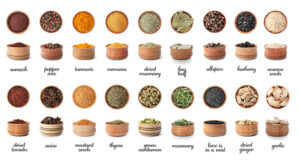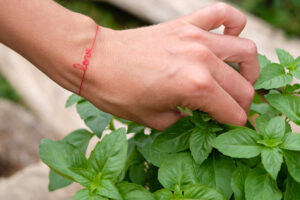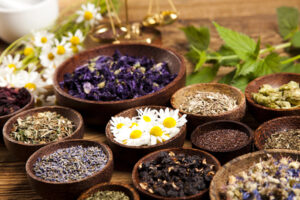Bitter Herbs: Significance, Uses, and Biblical Importance Bitter herbs have a rich history and hold significant cultural, culinary, and medicinal importance. From their crucial role in Passover traditions to their mention in the Bible, these herbs are revered for their distinctive flavors and health benefits. This article delves into what bitter herbs are, their […]
Bitter Herbs
Bitter Herbs: Significance, Uses, and Biblical Importance
Bitter herbs have a rich history and hold significant cultural, culinary, and medicinal importance. From their crucial role in Passover traditions to their mention in the Bible, these herbs are revered for their distinctive flavors and health benefits. This article delves into what bitter herbs are, their significance in the context of Passover, their mentions in the Bible, and provides recommendations for Amazon products to incorporate these herbs into your life.


What Are Bitter Herbs?
Bitter herbs refer to a variety of plants known for their sharp, pungent taste. These herbs are often used in cooking, traditional medicine, and religious ceremonies. Common examples include horseradish, endive, chicory, dandelion greens, and arugula. The bitterness of these herbs is attributed to the presence of various compounds, such as sesquiterpene lactones, which are believed to offer numerous health benefits including aiding digestion and detoxification.
Bitter Herbs in Passover
Passover, or Pesach, is a major Jewish holiday commemorating the Israelites’ exodus from Egypt. One of the key rituals during the Passover Seder is the consumption of bitter herbs, or maror, as a symbol of the bitterness and harshness of slavery endured by the Israelites. The Seder plate, a central element of the meal, includes various symbolic foods, with bitter herbs playing a pivotal role.
Traditionally, horseradish and romaine lettuce are used as bitter herbs during the Seder. The horseradish root is often grated and eaten, bringing tears to the eyes and a sharp reminder of the suffering. Romaine lettuce, while not as pungent initially, can have a bitter taste as one chews through the leaves. These herbs are consumed along with matzah (unleavened bread) and charoset (a sweet mixture of fruits and nuts), creating a balance of flavors and symbolizing the journey from slavery to freedom.
Bitter Herbs in the Bible
Bitter herbs are mentioned multiple times in the Bible, emphasizing their significance in ancient religious practices. One of the most notable references is in the Book of Exodus, which describes the first Passover meal:
“That same night they are to eat the meat roasted over the fire, along with bitter herbs, and bread made without yeast.” (Exodus 12:8)
This verse highlights the consumption of bitter herbs as part of the instructions given to the Israelites for the first Passover, establishing a ritual that continues to this day. The bitter herbs serve as a powerful symbol of the bitterness of slavery and the suffering endured by the Israelites in Egypt.
Beyond Passover, bitter herbs are also mentioned in various contexts throughout the Bible, often symbolizing suffering, repentance, and the need for spiritual cleansing.
Incorporating Bitter Herbs into Your Life
Incorporating bitter herbs into your diet can be beneficial for health. They are known for their digestive benefits, as they stimulate bile production, aiding in the digestion of fats and promoting detoxification. Additionally, bitter herbs can enhance the flavor of dishes, adding a unique sharpness that balances out other flavors.
Here are some recommended Amazon products to help you incorporate bitter herbs into your diet:
- J.R. Liggett’s Old-Fashioned Bar Shampoo – Tea Tree & Hemp Oil Formula
- Though not an edible herb, tea tree is known for its bitter properties and is often used for its antibacterial benefits.
- Organic Dandelion Root Tea
- Dandelion root is a classic bitter herb known for its detoxifying properties. This organic tea is a convenient way to enjoy its benefits.
- Horseradish Root Powder
- A versatile and convenient form of horseradish, perfect for adding a spicy kick to your dishes or using in traditional Passover meals.
- Endive Seeds for Planting
- Grow your own endive, a bitter leafy green that can be used in salads and other dishes for a fresh, sharp flavor.
- Romaine Lettuce Seeds
- Cultivate your own romaine lettuce, a staple bitter herb for Passover and a delicious addition to salads.
Bitter herbs are more than just plants with a sharp taste; they carry deep cultural, religious, and medicinal significance. From their integral role in the Passover Seder to their numerous health benefits, these herbs offer a unique combination of historical richness and practical uses. Whether you are looking to honor a tradition, explore biblical references, or simply enhance your diet, incorporating bitter herbs can provide a profound connection to the past and a pathway to better health.
The Fascinating World of Herb Names
The Fascinating World of Herb Names
Herbs have been an integral part of human history, utilized for their culinary, medicinal, and aromatic properties. The names of these herbs often carry fascinating histories, cultural significances, and etymological roots. This article delves into the origins and meanings of various herb names, providing insights into their historical contexts and highlighting notable books for those interested in further exploration.
Historical and Cultural Roots
Herb names are a testament to the rich tapestry of human culture and history. Many herbs have names derived from ancient languages, reflecting their long-standing importance in different societies. For example, basil comes from the Greek word “basileus,” meaning “king,” hinting at its revered status in ancient cultures. Basil was believed to have been used in royal rituals and was considered a symbol of love and protection.
Similarly, rosemary, a herb synonymous with remembrance and fidelity, derives its name from the Latin words “ros” (dew) and “marinus” (sea), meaning “dew of the sea.” This name reflects the herb’s Mediterranean origins, where it often grows near the coast. Rosemary has been used in various traditions and rituals, symbolizing memory and loyalty.
Etymological Mysteries
Some herb names have intriguing etymological backgrounds that reveal their uses and characteristics. Sage, for instance, comes from the Latin “salvia,” which is derived from “salvare,” meaning “to save” or “to heal.” This name underscores the herb’s historical use as a healing plant. Sage was highly valued in ancient medicine for its supposed ability to prolong life and improve mental clarity.
Another example is thyme, whose name comes from the Greek word “thymos,” meaning “courage.” In ancient Greece, thyme was associated with bravery and was often used in baths and burnt as incense to promote strength and courage. Its association with bravery continues today, as it is commonly used in aromatherapy for its invigorating scent.
Common Herbs and Their Meanings
Let’s take a closer look at some common herbs and the meanings behind their names:
- Parsley: The name “parsley” comes from the Greek word “petroselinon,” meaning “rock celery,” as it often grows on rocky hillsides. It symbolizes festivity and joy.
- Mint: Named after Minthe, a nymph in Greek mythology, mint is associated with hospitality and warmth. Its name signifies refreshment and energy.
- Dill: The name “dill” is derived from the Old Norse word “dilla,” meaning “to lull,” reflecting its historical use as a remedy for colic and insomnia.
- Oregano: From the Greek “origanon,” which combines “oros” (mountain) and “ganos” (joy), oregano means “joy of the mountain.” It is associated with happiness and health.
- Cilantro: Known as coriander in many parts of the world, the name “cilantro” comes from the Greek “koris,” meaning “bug,” due to the plant’s strong scent.
Notable Books on Herb Names and Their Histories
For those intrigued by the rich history and meanings behind herb names, several books offer detailed explorations into this fascinating subject. Here are a few notable recommendations:
- “The Complete Book of Herbs: A Practical Guide to Growing and Using Herbs” by Lesley Bremness – This comprehensive guide covers the cultivation and uses of herbs, including historical and cultural insights into their names and meanings.
- “Herbs: The Magic Healers” by Paul Twitchell – This book delves into the healing properties of herbs and includes sections on the etymology and historical significance of various herb names.
- “Culpeper’s Complete Herbal” by Nicholas Culpeper – A classic work in herbal literature, Culpeper’s book provides detailed descriptions of herbs, their names, and their medicinal uses, offering a historical perspective on herbal medicine.
- “Rodale’s Illustrated Encyclopedia of Herbs” by Claire Kowalchik and William H. Hylton – This encyclopedia offers an extensive look at the history, folklore, and uses of herbs, including the origins and meanings of their names.
- “The Herbalist’s Bible: John Parkinson’s Lost Classic Rediscovered” by Julie Bruton-Seal and Matthew Seal – This modern adaptation of Parkinson’s 17th-century work includes insights into the historical names and uses of herbs, bridging the past and present of herbal knowledge.
Herb names are more than mere labels; they are windows into the past, offering glimpses into the cultural, historical, and etymological richness of our botanical heritage. Understanding the origins and meanings of these names deepens our appreciation for the herbs we use in our daily lives, whether in the kitchen, garden, or medicine cabinet. By exploring the fascinating world of herb names and delving into notable books on the subject, we can connect more profoundly with the natural world and its timeless wisdom.
How to Harvest Basil
How to Harvest Basil: A Complete Guide for Thriving Plants
Basil is a beloved herb known for its aromatic leaves and versatile uses in various culinary dishes. Proper harvesting techniques are essential to ensure your basil plant remains healthy and continues to produce leaves throughout the growing season. In this comprehensive guide, we will cover how to harvest basil without killing the plant and how to harvest basil so it keeps growing. Additionally, we will review some tools that can make the process easier and more efficient.
Understanding Basil Growth
Before delving into harvesting methods, it’s important to understand how basil grows. Basil plants thrive in warm climates and can reach up to 24 inches in height. They grow leaves in pairs along the stem, and new growth emerges from the top. Understanding this growth pattern is key to effective harvesting.
When to Harvest Basil
The ideal time to start harvesting basil is when the plant has at least six to eight leaves, typically around six weeks after planting. Harvesting in the morning is best as the leaves are freshest. Avoid harvesting during the hottest part of the day to prevent wilting.
Tools Needed for Harvesting Basil
Using the right tools can make a significant difference in the health and productivity of your basil plant. Here are some tools that can help:
- Sharp Scissors or Pruning Shears: Essential for making clean cuts that do not damage the plant.
- Herb Stripper: Useful for quickly removing leaves from stems.
- Harvesting Basket: A container to collect the harvested leaves without crushing them.
Tool Reviews
1. Fiskars Softouch Micro-Tip Pruning Snip The Fiskars Softouch Micro-Tip Pruning Snip is an excellent tool for harvesting basil. Its sharp blades ensure clean cuts, which are crucial for promoting healthy regrowth. The soft-touch handle provides comfort during prolonged use.
Pros:
- Sharp, precise blades
- Comfortable handle
- Easy to clean
Cons:
- May be too small for larger hands
2. Chef’n LooseLeaf Kale, Chard, Collard Greens and Herb Stripper The Chef’n LooseLeaf Herb Stripper is a versatile tool that makes quick work of removing basil leaves from the stems. It features multiple hole sizes to accommodate different stem thicknesses.
Pros:
- Multiple hole sizes
- Easy to use
- Dishwasher safe
Cons:
- Only useful for leaf removal, not cutting
3. Garden Harvest Basket A sturdy, ventilated basket like the Garden Harvest Basket is perfect for collecting your basil harvest. It prevents the leaves from getting crushed and allows air circulation to keep them fresh.
Pros:
- Durable construction
- Good ventilation
- Large capacity
Cons:
- Takes up storage space
How to Harvest Basil Without Killing the Plant
- Identify the Right Stems: Look for stems that have at least six to eight leaves. These stems are mature enough to be harvested without causing harm to the plant.
- Cut Above a Leaf Pair: Use sharp scissors or pruning shears to make a clean cut just above a pair of leaves. This encourages the plant to produce two new stems from the cut point, leading to bushier growth.
- Avoid Over-Harvesting: Never remove more than one-third of the plant at a time. Over-harvesting can stress the plant and hinder its growth.
How to Harvest Basil So It Keeps Growing
- Regular Harvesting: Regularly harvesting basil encourages continuous growth. Aim to harvest every one to two weeks, depending on how quickly your plant grows.
- Pinch Off Flower Buds: If you notice flower buds starting to form, pinch them off immediately. Flowering can signal the end of the basil’s productive life, so removing buds redirects energy back to leaf production.
- Rotate Harvesting Areas: Avoid harvesting from the same spot each time. Rotate around the plant to ensure even growth and prevent overuse of any single area.
Additional Tips for Healthy Basil Plants
- Provide Adequate Sunlight: Basil thrives in full sunlight. Ensure your plant receives at least six hours of direct sunlight each day.
- Water Properly: Basil prefers moist soil but not waterlogged conditions. Water the plant deeply when the top inch of soil feels dry.
- Fertilize Moderately: Use a balanced, water-soluble fertilizer every four to six weeks to provide essential nutrients.
Harvesting basil correctly is crucial for maintaining a healthy, productive plant. By using the right tools and following proper techniques, you can enjoy a continuous supply of fresh basil leaves throughout the growing season. Regular harvesting, careful cutting, and proper plant care will ensure your basil plant remains vigorous and fruitful. Happy harvesting!
The Essential Guide to Culinary Herbs

Herbs are a cornerstone of culinary traditions around the world. They add flavor, aroma, and a touch of color to dishes, transforming ordinary meals into extraordinary experiences. This article delves into common herbs used in cooking, the best herbs to grow at home, the top choices for culinary use, and the various types of herbs you can incorporate into your cooking. [Read more…]
A Guide to Medicinal Herbs
The Ultimate Guide to Medicinal Herbs: Growing, Using, and Preserving
Medicinal herbs have been an integral part of traditional medicine for thousands of years. These natural remedies offer a wealth of health benefits, from boosting immunity to soothing digestive issues. Growing your own medicinal herbs can be a fulfilling and practical endeavor, providing fresh and potent ingredients for home remedies. This article explores medicinal herbs and plants, the best varieties to grow, and essential tips for cultivating your own herbal garden. We’ll also review a valuable book that can guide you through this journey. [Read more…]




